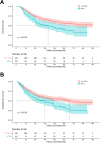Severe postoperative complications after minimally invasive esophagectomy reduce the long-term prognosis of well-immunonutrition patients with locally advanced esophageal squamous cell carcinoma
- PMID: 39673205
- PMCID: PMC11648140
- DOI: 10.1080/07853890.2024.2440622
Severe postoperative complications after minimally invasive esophagectomy reduce the long-term prognosis of well-immunonutrition patients with locally advanced esophageal squamous cell carcinoma
Abstract
Background: While severe postoperative complications (SPCs) impact cancer prognosis, their effect on locally advanced esophageal squamous cell carcinoma (ESCC) patients with varying immunonutritional statuses after minimally invasive esophagectomy (MIE) is unclear.
Methods: This retrospective study analyzed 442 patients with locally advanced ESCC who underwent MIE, investigating the relationship between SPCs and survival based on preoperative immunonutritional status, determined by the prognostic nutritional index (PNI). Nomograms were developed for patients with preserved immunonutritional status using Cox regression, and their performance was assessed.
Results: Of the patients, 102 (23.1%) experienced SPCs after MIE. Five-year overall survival (OS) and disease-free survival (DFS) were significantly different between SPCs and non-SPCs groups (p < 0.001). In the preserved immunonutritional group, SPCs significantly reduced 5-year OS (p = 0.008) and DFS (p = 0.011), but not in the poor immunonutritional group (OS p = 0.152, DFS p = 0.098). Multivariate Cox regression identified SPCs as an independent risk factor for OS (HR = 1.653, p = 0.013) and DFS (HR = 1.476, p = 0.039). A nomogram for predicting OS and DFS in preserved immunonutritional patients demonstrated excellent performance.
Conclusions: SPCs significantly affect prognosis in ESCC patients with preserved immunonutritional status after MIE. Nomograms based on SPCs can predict OS and DFS in these patients.
Keywords: Minimally invasive esophagectomy; esophageal squamous cell carcinoma; prognostic nutritional index; severe postoperative complications.
Conflict of interest statement
No potential conflict of interest was reported by the authors.
Figures





Similar articles
-
Preoperative immune prognostic index predicts the prognosis and postoperative adjuvant chemotherapy benefits of esophageal squamous cell carcinoma after minimally invasive esophagectomy.BMC Gastroenterol. 2025 May 8;25(1):344. doi: 10.1186/s12876-025-03959-z. BMC Gastroenterol. 2025. PMID: 40340583 Free PMC article.
-
Nomogram for prognosis of patients with esophageal squamous cell cancer after minimally invasive esophagectomy established based on non-textbook outcome.Surg Endosc. 2022 Nov;36(11):8326-8339. doi: 10.1007/s00464-022-09290-y. Epub 2022 May 12. Surg Endosc. 2022. PMID: 35556169 Clinical Trial.
-
Impact of minimally invasive total mesoesophageal excision and minimally invasive esophagectomy on failure patterns of locally advanced esophageal squamous cell carcinoma: a matched cohort study with long-term follow-up.Surg Endosc. 2023 Oct;37(10):7698-7708. doi: 10.1007/s00464-023-10334-0. Epub 2023 Aug 10. Surg Endosc. 2023. PMID: 37563344
-
Robotic Versus Conventional Minimally Invasive Esophagectomy for Esophageal Cancer: A Meta-analysis.Ann Surg. 2023 Jul 1;278(1):39-50. doi: 10.1097/SLA.0000000000005782. Epub 2022 Dec 20. Ann Surg. 2023. PMID: 36538615 Review.
-
Recent advances in minimally invasive esophagectomy for squamous esophageal cancer.Ann N Y Acad Sci. 2020 Dec;1482(1):113-120. doi: 10.1111/nyas.14461. Epub 2020 Aug 11. Ann N Y Acad Sci. 2020. PMID: 32783237 Review.
Cited by
-
Risk factors associated with failure to rescue after minimally invasive Ivor Lewis esophagectomy.Surg Endosc. 2025 Jul 14. doi: 10.1007/s00464-025-11949-1. Online ahead of print. Surg Endosc. 2025. PMID: 40659946
References
MeSH terms
LinkOut - more resources
Full Text Sources
Other Literature Sources
Medical
